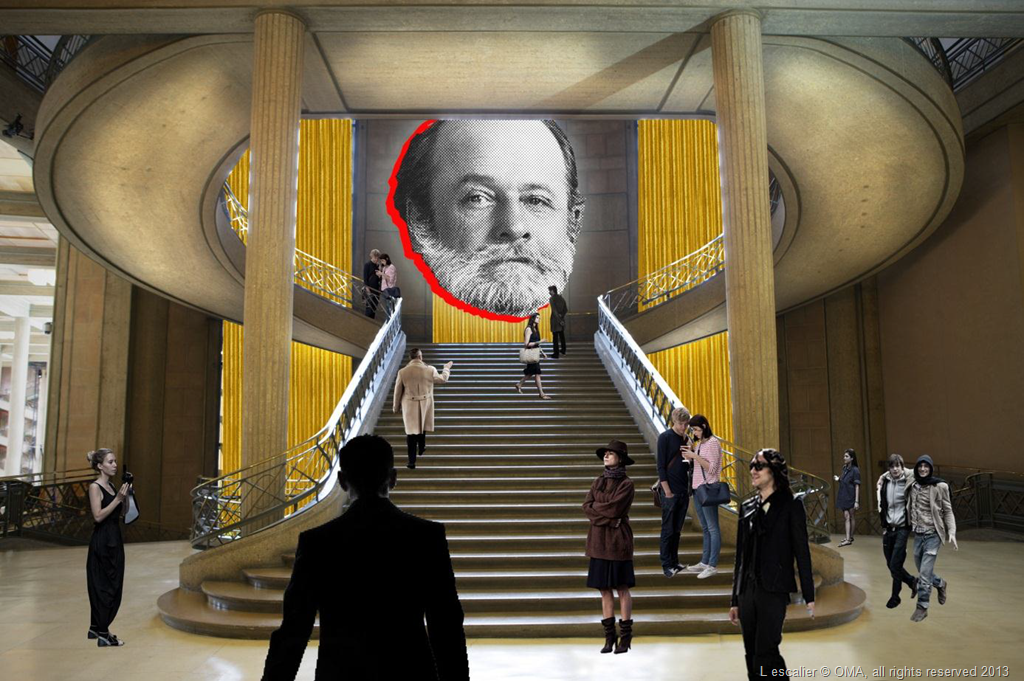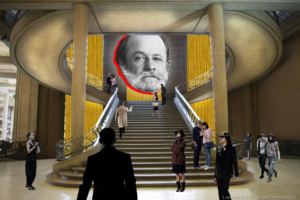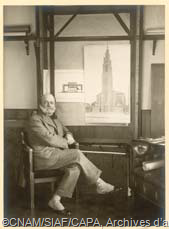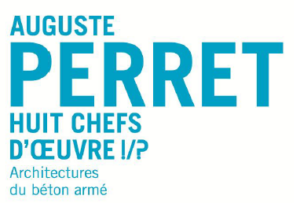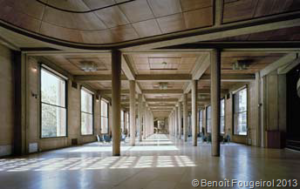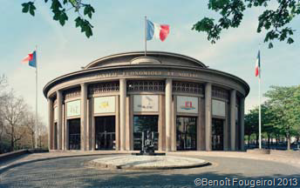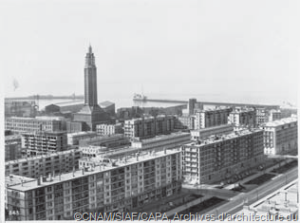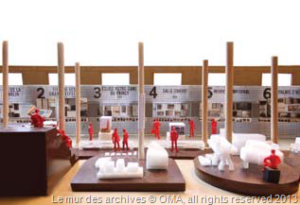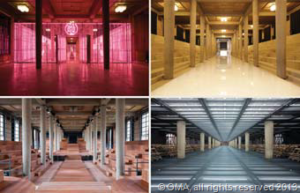Paris, 7 October 2013
On view from 27 November 2013 to 19 February 2014, the exhibition "Auguste Perret, Huit Chefs d’oeuvre !/? – Architectures du béton armé" ("Auguste Perret: Eight Masterpieces!/? – Reinforced Concrete Buildings") is organised by the Economic, Social and Environmental Council (ESEC) in collaboration with Fondazione Prada at the Palais d’Iéna – ESEC headquarters. For this tribute to one of the most inspiring architectural careers of the 20th century, Joseph Abram, the scientific curator is in charge, with his team, of the theoretical and historical coherence of the project.
Auguste Perret, 1925
Son of a stonemason who had taken part in the Paris Commune uprising in 1871, Auguste Perret (1874–1954) played a core part in defining a specific aesthetic for reinforced concrete. His entire career was devoted to a rigorous practice of architecture based on innovative strategies that combined intellect, design and construction into a powerful creative mechanism that generated an impressive number of masterpieces. His talent received due recognition in 2005 when part of his oeuvre was added to the UNESCO World Heritage List.
While several exhibitions have been dedicated to Auguste Perret, this exhibition has the ambitious goal to share with a wider audience the intimacy of a creative process that is amongst the highest in the history of architecture.
It is only natural that the chosen venue is the Palais d’Iéna, one of Perret’s most significant projects. Perret invented a new classical order comparable to those of ancient times but rooted in modern construction techniques: the reinforced concrete order, with the Palais d’Iéna as its finest achievement.
The presentation of this major event at the Palais d’Iéna reflects the ESEC’s policy of hosting cultural and artistic projects as a stimulus for public dialogue, also promoted by many events and debates organized within the institution. A cultural programme will run during the exhibition dedicated to Auguste Perret: the Palais will be opening its doors to the public and will host talks, debates, workshops, concerts and screenings in the hemicycle.
THE EXHIBITION: "EIGHT MASTERPIECES!/?"
With a solid theoretical perspective and today’s production possibilities, the exhibition aims at a thoroughgoing transformation of the way this intellectual builder is seen. The focus is on eight major works: in Paris, immeuble de la Rue Franklin (1903), Théâtre des Champs-Elysées (1913), église Notre Dame du Raincy (1923), salle Cortot (1929), Mobilier national (1937) and Palais d’Iéna (1939); and in Le Havre, Hôtel de Ville (1957) and église Saint Joseph (1956). With their technical inventiveness and unique relationship with their materials, these eight buildings represent a decisive addition to 20th-century architecture.
Salle hypostyle
The Palais d’Iéna itself is the first exhibit. For the exhibition, located in the pillared hypostyle room, OMA AMO has reused designs made for earlier Prada events: since 2011 the office has been exploring the interior of the Palais in its staging of fashion parades and cultural events. The scenography of the exhibition is a collage of these explorations, designed as contemporary interpretations of Perret’s architecture. This temporary construction – this building within a building – is a deeply contextual installation that highlights the enduring virtues of its concrete setting.
Palais d Iena
Among the numerous archival items that introduce the eight masterworks are:
- Some 100 original architectural drawings from the Perret agency
– Photographs from the Chevojon studio, that worked intimately with the Perret office over five decades
- Analytical models
– A fascinating mixed bag of personal and biographical material: letters, albums, objects, books, magazines, etc.
The exhibition includes over 400 original items, some of them on public display for the first time. Lenders include the Cité de l’Architecture et du Patrimoine, Le Havre municipal archives, the Musée Maurice Denis, the Bibliothèque littéraire Jacques Doucet, the Corbusier Foundation, the Musée Bourdelle, the Musée des Années Trente, the Musée des Arts Décoratifs, the Friends of Auguste Perret, the Conservatoire National des Arts et Métiers (CNAM) and the Musée des beaux-arts in Grenoble.
Le Havre, vue aerienne vers l eglise Saint Joseph
A COLLABORATIVE PROJECT
As a complement to the indispensable contributions from scientific curator Joseph Abram and the OMA AMO architecture office, under the direction of artistic curator Rem Koolhaas, the national schools of architecture in Versailles and Nancy have provided input under the supervision of their respective directors: early in 2013 Vincent Michel and Lorenzo Diez set up a team of teachers, researchers and students to lead a prospective project. Sixteen students from Versailles came up with eight projects for the exhibition, aimed at stimulating interest in the architectural, constructive, conceptual and cultural aspects of Auguste Perret’s legacy.
In addition artists have been called in to give a contemporary outlook on the buildings’ on-going existence and evolution: Gilbert Fastenaekens’ photographs show the traces of human activity while Louise Lemoine and Ila Bêka film the residents and the use of these places. The result is an eloquent expression of the buildings’ intangible aspects.
"Since 1959 the Economic, Social and Environmental Council has been making Auguste Perret’s Palais d’Iéna a lively, welcoming venue for the endless diversity of human activity: discussion and debate for the honing of convictions through dialogue; art and culture as a window onto otherness through shared feelings; and festive events. In a somewhat bewildered society looking to the future with anxiety and seeing rapid, radical change in a world it can no longer grasp nor control, art remains a vital challenge, a way of projecting ourselves into the times ahead. I sincerely hope that this exhibition, in bringing together the Palais d’Iéna and other major works by Auguste Perret, will represent a further step in ESEC’s responsiveness to cultural and artistic initiatives." – Jean-Paul Delevoye, President ESEC
OMA au Palais d Iena
Joseph Abram
Architect/historian Joseph Abram is a teacher at the National School of Architecture in Nancy and a researcher at the History of Contemporary Architecture Workshop. He has published many books on 20th-century architecture and curated some thirty exhibitions.
The OMA AMO agency
OMA is a leading international partnership practicing architecture, urbanism, and cultural analysis. The research studio AMO operates in areas beyond the traditional boundaries of architecture, including media, politics, sociology, renewable energy, technology, fashion, curating, publishing, and graphic design.
HONOUR COMMITTEE
The Honour Committee of the exhibition « Auguste Perret, Huit Chefs d’oeuvre !/? – Architectures du béton armé » is composed by Jean-Paul Delevoye, President of the Economic, Social and Environmental Council (ESEC); Miuccia Prada and Patrizio Bertelli, Presidents of Fondazione Prada; Édouard Philippe, Seine Maritime Deputy and Mayor of Le Havre; Antoine Rufenacht, former Mayor of Le Havre; Vincent Berjot, General Director for Heritage, Ministry of Culture and Communication; Guy Amsellem, President of the Cité de l’Architecture et du Patrimoine; Raymond Soubie, Chairman of the Board of the Théâtre des Champs-Élysées ; Annie Perret and Christophe Perret; Benjamin Mouton, President of the association of Friends of Auguste Perret.
VISIT INFORMATION
The exhibition is open daily from 27 November 2013 to 19 February 2014 (11am – 6pm) Closure days: 14 December, 25 December and 1 January
Free admission
Address: Palais d’Iéna, ESEC headquarters | 9 place d’Iéna – 75016 Paris
Underground: Iéna stop (Line 9) and Trocadéro stop (Line 6)
Bus: Iéna stop (Lines 32, 63 and 82)
Further information: www.expositionperret.fr |
#perret to follow the exhibiton on twitter
With the support of:

